Clinical Decision Unit Admission Criteria: Guiding Quality Care and Resource Allocation
In a fast-paced healthcare ecosystem, every decision and its timing impacts lives. This is why a Clinical Decision Unit (CDU) is essential for bridging the gap between observation and critical care.
The CDU floor in hospitals is often buzzing with the need for precise admission criteria, ensuring patients receive the right level of care while optimizing resource allocation. In such situations, you need to answer one key question concerning the criteria for hospital admission: “Who needs immediate inpatient care?”
The key to consistently and accurately answering this question is clear-cut clinical decision unit admission criteria. These criteria will go beyond serving as guidelines for determining medical necessity for hospital admission. They’re your foundation for a patient-centric approach to care that will enhance outcomes and customer satisfaction.
By establishing strict yet well-defined benchmarks for admission, you can ensure patients receive the appropriate level of attention based on the severity of their condition. This safeguards patients from unnecessary hospital stays and prevents resource strain by reserving inpatient resources for those requiring them.
As such, medical necessity should be at the core of your CDU admission criteria. This concept focuses on delivering ideal care to each patient. With that in mind, healthcare providers must determine the most suitable care setting for each patient, and the process involves determining if the patient’s condition warrants inpatient care.
Effectively assessing the medical necessity of hospital admission allows your CDU to balance optimal care and resource efficiency. Moreover, it ensures your patients receive the right care intensity without unnecessarily burdening the hospital’s resources.
But first, you’ll need to navigate the complex clinical decision unit admission criteria to determine what will work best for your facility. These criteria should consider key factors, including the complexity of the medical condition, the need for further diagnostic evaluation, and the potential trajectory of the patient’s recovery.
In a healthcare landscape where precision saves lives and resources, the importance of well-defined CDU admission criteria cannot be overstated. These criteria act as the lighthouse, guiding the ship of patient care through the stormy seas of medical decision-making.
When the criteria are accurate, patients benefit from timely, appropriate care, leading to improved outcomes. Hospitals, too, benefit by channeling their resources where they are needed the most, preventing bottlenecks and enhancing overall operational efficiency.
Clinical Decision Unit vs. Observational Unit: Navigating Healthcare’s Care Continuum
Within the intricate web of a hospital’s bustling environment, two distinct players emerge: the Clinical Decision Unit (CDU) and the Observational Unit. While sharing the common goal of delivering effective patient care, these units are tailored to specific scenarios, each holding a unique position in the healthcare ecosystem.
The Clinical Decision Unit (CDU) is the dynamic hub where medical puzzle pieces are analyzed and connected. It’s the mid-ground between inpatient and observation, designed for patients requiring intensive diagnostic evaluation, treatment adjustments, or monitoring but whose medical status is yet to show whether full inpatient care is necessary.
On the other hand, the Observational Unit is a strategic space within a hospital where patients are closely monitored for a brief period, typically less than 24 hours. It’s an interim area used to determine if a patient’s condition warrants admission or if they can be safely discharged.
Here are some more distinguishing factors to help you tell the two units apart:
1. Severity of Condition and Objective of Care
Serving as the hospital’s command center for complex cases, patients in the CDU have more severe medical conditions. As a result, patients in this unit generally have a longer length of stay than those in the observation unit.
In the latter, patients mainly require short-term observation, often for diagnostic clarification or monitoring post-procedure. The Observation Unit stabilizes patients efficiently before deciding whether to admit or release them for outpatient care.
2. Inside the Units
Picture a CDU floor as a hive of activity where healthcare professionals, armed with cutting-edge tools, unravel medical mysteries. It accommodates patients needing extended observation and intensive interventions.
On the other hand, a hospital Observation Unit provides streamlined care, ensuring patients receive necessary treatments while their cases are meticulously evaluated. It’s a strategic link that prevents unnecessary admissions while safeguarding patient well-being.
3. Operating Guidelines
Both the CDU and Observation Unit adhere to specific guidelines that outline their functioning. The CDU focuses on in-depth diagnostics and ongoing interventions, following stringent protocols to ensure patient safety.
Conversely, hospital Observation Unit guidelines facilitate swift evaluations and decisions while maintaining a high standard of care.
4. A Finely Tuned Symphony
In the grand scheme, CDUs and Observation Units play two distinct but essential roles that complement the facility’s desire to offer quality care and optimize resource use.
Therefore, understanding the differences between the units and optimizing their functions is essential to enhanced care and patient outcomes.
Unveiling CDU Admission Requirements: Navigating the Gateway
The quality of care you offer comes down to your precision and swiftness, making a Clinical Decision Unit a key factor. To get the maximum value from your CDU, you must have clear clinical decision unit guidelines.
In essence, CDU admission requirements serve as a filter to capture patients at the crossroads of care intensity. This includes patients with:
-
- Complex medical conditions
- Uncertain diagnostic pathways
- Patients requiring careful evaluation
These requirements function as gatekeepers, channeling patients who demand extensive assessment and treatment into the CDU, thus preventing overloading inpatient resources.
The Role of Clinical Decision Rules
Clinical decision rules are the core of CDU admission requirements — a set of guidelines designed to streamline the admission process. These rules result from meticulous research and expert consensus, serving as the framework for deciding which patients are best suited for CDU care.
They incorporate various factors, including patient status criteria such as medical history, presenting symptoms, and potential recovery trajectory. These rules aren’t rigid; they’re adaptable to the ever-evolving landscape of medical knowledge.
What Type of Patients Are in the CDU?
People admitted to the CDU are in the gray area of medical care. These units welcome many types of patients, from individuals with acute exacerbations of chronic conditions to those with perplexing symptoms that demand close scrutiny.
How long can you stay in CDU?
The primary objective of a clinical decision unit is to optimize length of stay and resource utilization. As such, you can only stay in the CDU for six to 48 hours.
While in the CDU, medical professionals perform diagnostics to determine the appropriate next steps in your care journey. However, the duration can be extended if the patient’s condition stabilizes quickly or additional evaluation is required.
Empowering Precision Care
CDU admission requirements are an invaluable asset as the need to offer improved healthcare services increases. They allow you to offer precision care where it matters most.
Whether it’s a patient requiring intensive observation before a definitive diagnosis or one needing close management of their chronic ailment, the CDU admission requirements guide patients toward the care they need.
Navigating CDU Admission Processes for Optimal Outcomes
In modern healthcare, the secret to success is efficiency. As such, while the CDU bridges the gap between inpatient care vs. observation, it must be optimized to enhance outcomes.
In this regard, you must have a meticulously designed CDU admission process to ensure patients receive the right care at the right time, leading to optimal patient outcomes. This is where clinical decision support systems come into play.
With such a system, you’ll have a digital assistant with a wealth of medical knowledge and real-time data. It will align patient symptoms and history with evidence-based admission criteria for CDU to facilitate accurate decision-making, enabling your healthcare team to offer the most appropriate level of care.
Evidence-Based Admission Criteria: Paving the Road to Success
Evidence-based criteria drive the CDU admission process. It’s a set of standards meticulously crafted to ensure optimal patient outcomes. But it’s not just about having a set of checkboxes. Your criteria should be based on clinical expertise and extensive research to pinpoint patients who can benefit the most from CDU care.
This strategic approach guarantees that patients receive the care intensity they need, preventing overutilization of inpatient resources.
The Journey Towards Optimal Outcomes
Every step within the CDU admission process is geared toward one ultimate goal: optimal patient outcomes. Through swift, precise admission, patients undergo quicker diagnostic evaluations, receive tailored treatments, and benefit from focused monitoring.
By accessing the CDU’s specialized care, patients experience the advantages of streamlined attention, leading to faster recoveries and reduced hospital stays.
Streamlined Decisions: Revolutionizing Admission Criteria with EvidenceCare’s AdmissionCare Software
As you prepare to automate admission criteria, your chosen partner is as important as your guidelines and criteria. With a team of health industry experts and years of experience in delivering cutting-edge solutions to hospitals, EvidenceCare’s AdmissionCare software is the ideal solution.
Our admission criteria software isn’t just another tool; it’s a powerhouse that automates the often intricate process of choosing the right patient status—whether inpatient or observation. AdmissionCare goes beyond numbers and offers precise admission criteria by ensuring that medical necessity documentation is solid, guiding doctors toward informed decisions.
Ultimately, our patient status software is an enabler for your team, freeing valuable time and resources while ensuring that patients receive the care that aligns perfectly with their medical needs.
In a world where efficiency and precision reign supreme, AdmissionCare is the beacon that illuminates the path to optimal patient outcomes.
Schedule a demo today to deliver enhanced patient outcomes by automating admission criteria with AdmissionCare.











